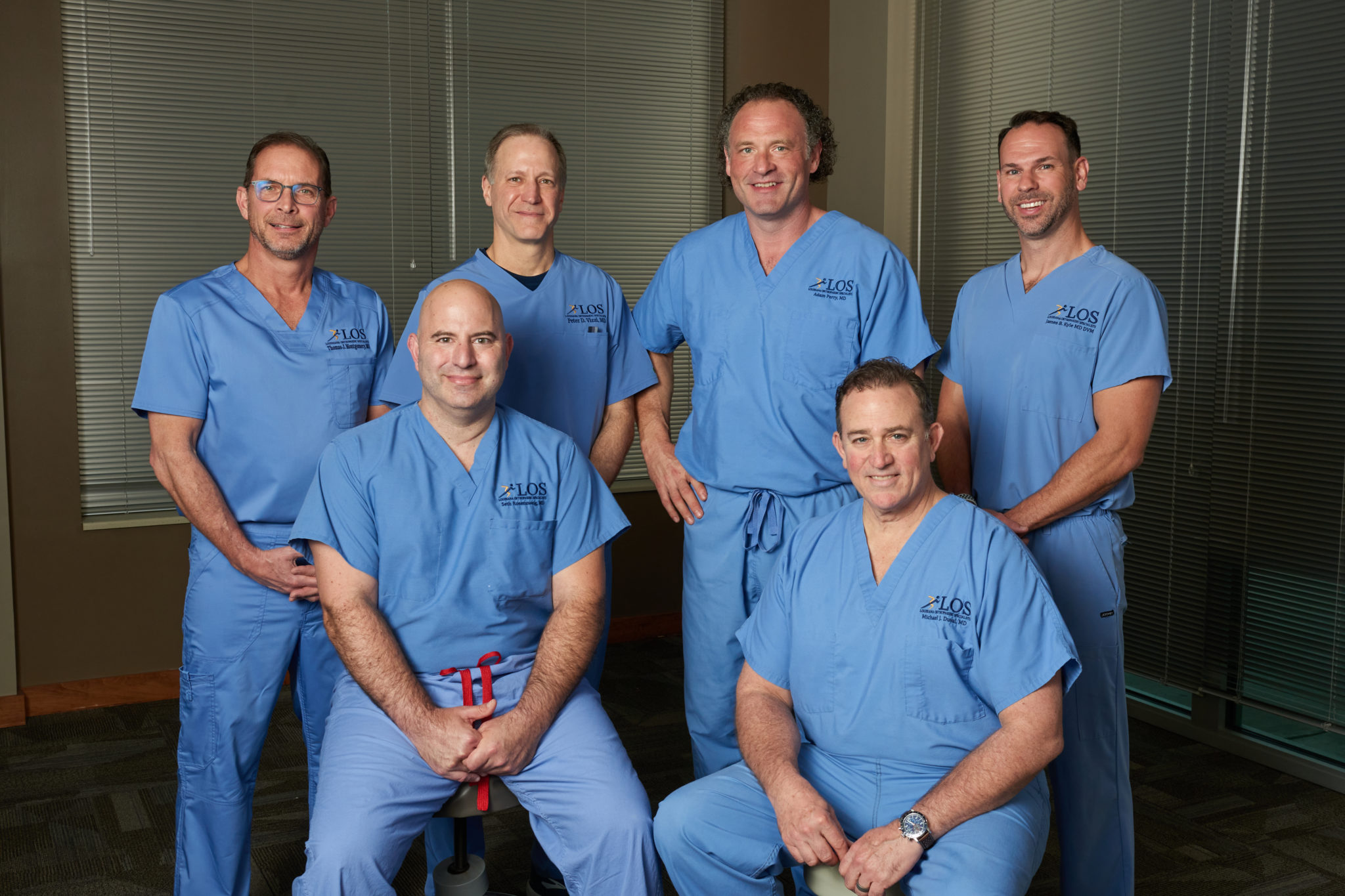TOTAL JOINT REPLACEMENT SURGERY

STANDING L-R: Dr. Thomas Montgomery, Dr. Peter Vizzi, Dr. Adam Perry, Dr. James B. Kyle
SEATED L-R: Dr. Seth Rosenzweig, Dr. Michael Duval
Patient Stephen Funderburk discussing his total hip replacement surgery.
“Evidence supports decreased pain and improved function in the first six weeks postoperatively compared to posterior approach. With the use of fluoroscopy, the direct anterior approach also allows me the ability to see in real time the sizing and positioning of components.” – James B Kyle, MD, DVM
“Not only does the anterior hip replacement allow us to place the implants more precisely than traditional techniques. This improved accuracy translates into superior patient recovery.” – Seth Rosenzweig, MD
“The direct anterior approach will give the patient a much better result with less risks.” – Adam Perry, MD
“Collectively, we have more than 15 years of experience and have worked on hundreds of cases with far superior results in terms of recovery time and patient results” – Michael Duval, MD
Total Joint Replacement Surgery
Hip joint, knee joint and shoulder joint replacements are helping people of all ages live pain- free, active lives.
When our patients are injured, suffer from an illness or simply get older, the cartilage around their joints becomes damaged and the tissues around the joint become inflamed. With time, the cartilage wears away, allowing the rough edges of bone to rub against each other, causing even more pain. Our surgeons are often able to repair minor damage, but in more severe cases, a total joint replacement is necessary.
The total joint procedure has proven to significantly improve early outcomes and decrease recovery time, allowing patients to return to a normal lifestyle. Our anterior approach to hip replacement surgery means less damage to major muscles, less postoperative pain, faster recovery and decreased risk of hip dislocation.
We hope you will rely on our highly-skilled team of surgeons and physicians to discuss your options, provide you with an effective treatment plan, and get you back to feeling your very best.
Total Knee Replacement (TKR)
A total knee replacement (TKR) or total knee arthroplasty is a surgery that resurfaces an arthritic knee joint with an artificial metal or plastic replacement parts called the ‘prostheses’.
Robot Assisted Total Knee Replacement
Benefits of Minimally Invasive Robotic Total Knee Replacement Surgery
Minimally invasive robotic knee surgery is a technique that permits the surgeons at Louisiana Orthopaedic Specialists to customize the procedure to the patient’s anatomy. This will improve both the patient’s recovery and knee replacement function. It is important to understand that the decision to receive these procedures is individualized to the patient and the patient’s symptoms. It is important to discuss with our surgeons whether minimally invasive robotic total knee surgery is right for you.
Contact Louisiana Orthopaedic Specialists today to determine if you are a candidate for minimally invasive robotic total knee replacement surgery.
ROSA-Available in Lafayette with Dr. Adam Perry, Dr. James B. Kyle, Dr. Michael Duval, Dr. Thomas Montgomery, and Dr. Peter Vizzi
– Rosa uses flexible imaging modalities, including x-ray based imaging and imageless options, allowing surgeons and patients reduced imaging costs and convenience in preparing for surgeries. Preoperative planning with 2D x-ray to 3D bone modeling X-Atlas™ technology limits instrumentation in the operating room and facilitates custom plans based on a patient’s unique anatomy.
– The ROSA robot optimizes the accuracy of a knee replacement procedure by customizing to the patient’s individual anatomy. This advanced technology will improve both the recovery for our patients and the function of the knee replacement.
Please review this brochure for more information on the Rosa Knee System.
Mako-Available in New Iberia with Dr. Seth Rosenzweig
– Mako Robotic-Arm Assisted Total Knee replacement is a treatment option for adults living with mid to late-stage osteoarthritis (OA) of the knee. Mako provides you with a personalized surgical plan based on your unique anatomy. First, a CT scan of the diseased knee joint is taken. This CT scan is uploaded into the Mako System software, where a 3D model of your knee is created. This 3D model is used to pre-plan and assist your surgeon in performing your total knee replacement.
Anterior Approach to Hip Replacement
The fellowship-trained surgeons at Louisiana Orthopaedic Specialists provide our patients in Lafayette, New Iberia with the distinct advantage of cumulative team experience in performing Anterior Hip Replacements. This total joint procedure has proven to significantly improve early outcomes and decrease recovery time, allowing patients to return to a normal lifestyle.
Anterior approach to hip replacement surgery conducted by a surgeon at Louisiana Orthopaedic Specialists offers several advantages, including:
Less damage to major muscles. The direct anterior approach avoids cutting major muscles. There are fewer muscles at the front of the hip, and our fellowship-trained surgeons work between them, rather than cutting through muscle tissue or detaching muscles from bones and then having to make repairs at the end of the surgery.
Less postoperative pain. Because the surgery does not require cutting major muscles, patients typically experience less pain after surgery and require less pain medication.
Faster recovery. After surgery, a patient can bend at the hip and bear weight as soon as it is comfortable. Most anterior hip replacement patients can use crutches or a walker sooner than patients who have had a traditional surgery. Patients may also walk on their own sooner.
Decreased risk of hip dislocation. A major post-surgical concern for hip replacement patients is that the new implant (ball and socket) will dislocate. Most studies show lower dislocation rate versus the posterior approach.
